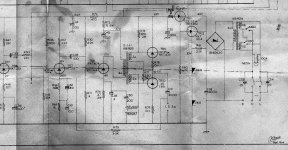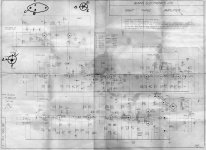Hi everyone,its been a while....
I have a Burns Orbit Three mid sixties transistor amp,60w,3x10inch 5ohm speakers.
One speaker is blown and the original wiring has been tampered with and is trashed.
Diagram shows load of 2 ohms.
I need advice on how best to wire in new speaker.
3 series gives 15ohm,20 per speaker.
3 para gives 1.666ohm 20w per speaker.
2ser/1 para gives 3.3ohm,10w 10w 40w per speaker.
2para/1ser gives 7.5ohm 10w 10w 40w per speaker.
Which configuration should I use?
Info about this amp is almost non existant-need help.
http://burns-amps.blogspot.co.uk/
I have a Burns Orbit Three mid sixties transistor amp,60w,3x10inch 5ohm speakers.
One speaker is blown and the original wiring has been tampered with and is trashed.
Diagram shows load of 2 ohms.
I need advice on how best to wire in new speaker.
3 series gives 15ohm,20 per speaker.
3 para gives 1.666ohm 20w per speaker.
2ser/1 para gives 3.3ohm,10w 10w 40w per speaker.
2para/1ser gives 7.5ohm 10w 10w 40w per speaker.
Which configuration should I use?
Info about this amp is almost non existant-need help.
http://burns-amps.blogspot.co.uk/
Last edited:
I would think that all three speakers would have been wired in parallel. Seeing how one speaker is blown be careful wiring the remaining two in parallel if their power handling isn't adequate (30 watts each). You will get a loss of output power since the load impedance increased from 1.66 ohm to 2.5 ohm but shouldn't be too noticeable.
Or you could wire the remaining two in series but at a cost of a lot less power output.
Or you could wire the remaining two in series but at a cost of a lot less power output.
Last edited:
I suspected 1.66 or 3.3 ohms was the right combination.Maybe the manufacturer just rounded the 1.66 ohms up to 2ohms for convience.
I tested the amp with 2 remaining speakers in paralell,unusually loud even at volume setting of 2.
i will wire all 3 in paralell methinks.
Now a new problem,vibrato has stopped working.I think squirt of contact cleaner on the pots is the first thing to try.
I tested the amp with 2 remaining speakers in paralell,unusually loud even at volume setting of 2.
i will wire all 3 in paralell methinks.
Now a new problem,vibrato has stopped working.I think squirt of contact cleaner on the pots is the first thing to try.
I would think that all three speakers would have been wired in parallel. Seeing how one speaker is blown be careful wiring the remaining two in parallel if their power handling isn't adequate (30 watts each). You will get a loss of output power since the load impedance increased from 1.66 ohm to 2.5 ohm but shouldn't be too noticeable.
Power handling doesn't alter as the speakers are in parallel - each speaker only gets 20W regardless of one, two or three speakers in parallel.
This is fairly normal with any transistor amp, but more so in this case (as according to the schematic on the link above it uses a 33V stabilised PSU).
However, I'd a little dubious about it's 60W power output, although I suppose it might just make it at high levels of distortion - but unlikely to at clean power levels.
Presumably the speakers were specially made?, as 5 ohms isn't a normal value?, and it was certainly unusual to have an amp made for 2 ohm speakers way back then.
"Power handling doesn't alter as the speakers are in parallel - each speaker only gets 20W regardless of one, two or three speakers in parallel."
How do you figure? Do you mean the speaker can only "handle" 20 watts instead of "gets" 20 watts?
The amp doesn't care how many speakers it has hooked up it just sees a load. With two 5 ohm speakers in parallel you get 2.5 ohms. The amp is rated at 60 watts into a 2 ohm load. I was assuming the manufacturer used 3 twenty watt speakers combining to handle the 60 watts. Take one speaker away and now you get a power handling of only 40 watts. Take another away and your left with one speaker than can only handle 20 watts. I agree if you are saying that with that one speaker left you have less of a load at 5 ohms so the amp will put out less power than the rated 60 watts but that doesn't mean that the amp will only put 20 watts through a 20 watt speaker.
How do you figure? Do you mean the speaker can only "handle" 20 watts instead of "gets" 20 watts?
The amp doesn't care how many speakers it has hooked up it just sees a load. With two 5 ohm speakers in parallel you get 2.5 ohms. The amp is rated at 60 watts into a 2 ohm load. I was assuming the manufacturer used 3 twenty watt speakers combining to handle the 60 watts. Take one speaker away and now you get a power handling of only 40 watts. Take another away and your left with one speaker than can only handle 20 watts. I agree if you are saying that with that one speaker left you have less of a load at 5 ohms so the amp will put out less power than the rated 60 watts but that doesn't mean that the amp will only put 20 watts through a 20 watt speaker.
Last edited:
"Power handling doesn't alter as the speakers are in parallel - each speaker only gets 20W regardless of one, two or three speakers in parallel."
How do you figure? Do you mean the speaker can only "handle" 20 watts instead of "gets" 20 watts?
The amp doesn't care how many speakers it has hooked up it just sees a load. With two 5 ohm speakers in parallel you get 2.5 ohms. The amp is rated at 60 watts into a 2 ohm load. I was assuming the manufacturer used 3 twenty watt speakers combining to handle the 60 watts. Take one speaker away and now you get a power handling of only 40 watts. Take another away and your left with one speaker than can only handle 20 watts. I agree if you are saying that with that one speaker left you have less of a load at 5 ohms so the amp will put out less power than the rated 60 watts but that doesn't mean that the amp will only put 20 watts through a 20 watt speaker.
The speaker can't handle more than 20 watt, when they are wired in parallel. In series it would be 20+20+20 = 60 watt for the whole system. But now it's 15 ohm and will require more power to play loud., but this i parallel and then 20+20+20=20. But now it's 1,66 ohm and will play louder than a 15 ohm system.
I agree if you are saying that with that one speaker left you have less of a load at 5 ohms so the amp will put out less power than the rated 60 watts but that doesn't mean that the amp will only put 20 watts through a 20 watt speaker.
Do the maths
It's hardly difficult - each speaker gets 20W, with three speakers the amp outputs 60W, with two speakers it outputs 40W, and with one speaker only 20W.
So yes, it DOES mean the amp will only output 20W through a single speaker (of the designated impedance).
"So yes, it DOES mean the amp will only output 20W through a single speaker (of the designated impedance)."
Yes I agree.
I was trying to clarify for people reading that it's not because of the wattage rating of the speaker (say 20w) that the amp puts out 20w but because of the designated impedance of the speaker.
Yes I agree.
I was trying to clarify for people reading that it's not because of the wattage rating of the speaker (say 20w) that the amp puts out 20w but because of the designated impedance of the speaker.
BURNS ORBIT
Burns did indeed quote 60 watts output for these amps, considering that transistor technology for guitar amps was in its infancy back then your amp has done very well to last this long, I think they were designed and built by Fenton-Weill for Burns, nice amp's and obviously reliable !Hi everyone,its been a while....
I have a Burns Orbit Three mid sixties transistor amp,60w,3x10inch 5ohm speakers.
One speaker is blown and the original wiring has been tampered with and is trashed.
Diagram shows load of 2 ohms.
I need advice on how best to wire in new speaker.
3 series gives 15ohm,20 per speaker.
3 para gives 1.666ohm 20w per speaker.
2ser/1 para gives 3.3ohm,10w 10w 40w per speaker.
2para/1ser gives 7.5ohm 10w 10w 40w per speaker.
Which configuration should I use?
Info about this amp is almost non existant-need help.
BURNS amplifiers-guitars
Burns did indeed quote 60 watts output for these amps, considering that transistor technology for guitar amps was in its infancy back then your amp has done very well to last this long, I think they were designed and built by Fenton-Weill for Burns, nice amp's and obviously reliable !
Pretty crude, even by the standards back then - reliability was helped (greatly) by using a transformer driver, making the amp far simpler and immune to the 'domino' effects in DC coupled amplifiers.
Back in the early 70's we upgraded to a 125W TUAC power amplifier module for doing disco's, it never failed despite plenty of use and abuse - unlike the numerous DC coupled amps we had used previously.
The 'problem' with such designs of course is sourcing the special transformers required
- Status
- This old topic is closed. If you want to reopen this topic, contact a moderator using the "Report Post" button.
- Home
- Live Sound
- Instruments and Amps
- Burns Orbit Three

